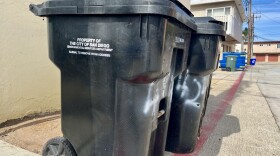Many dance organizations in San Diego are feeling the pressure from funding cuts and other changes to the arts landscape.
"We were awarded a National Endowment for the Arts grant, got the award letter, the whole nine yards, to fund programming in this calendar year — January to December. So we started the program and spent funds toward it. We got an email about two weeks ago, on a Friday at 6:30 p.m., saying that the grant had been revoked," said Matt Carney, executive director of the San Diego Ballet.
The nonprofit, and many other groups in the local dance community, are navigating funding challenges.
"There's also almost a loss of confidence and an increase in fear about how we can sustain moving forward," Carney said.
Zaquia Mahler Salinas, founder of the contemporary movement nonprofit organization Disco Riot, said the impacts from funding cuts are both direct and indirect.
"Some of the changes in funding at the local level, with the libraries and Parks and Rec — we also run programs out of library spaces and through Parks and Rec that are public-facing programs. So I think all across the board, we're definitely seeing these cuts as having some impact on our programming and we are having to reshape programming due to the loss of funds," Salinas said.
Salinas also said that, more broadly, arts funding systems have long been unsustainable.
"For a long time, we haven't done a great job of resourcing art in this country. It hasn't been a primary focus. So while these cuts are absolutely devastating, the thing that concerns me the most is the cultural component — that if the community does not show up and remember the value of art as a component of our culture, as a piece of our cultural fabric — that, to me, is maybe the most dangerous thing that we're facing right now."
Interview highlights
On the broad local impacts of funding cuts
Zaquia Mahler Salinas: For Disco Riot, we've definitely seen some impacts from the NEA at the federal level. We had a proposal for our S P A C E (Alliance Studio) Residency project that we do annually that now just has sort of disappeared. At the state level, we've seen some changes in funding that support our Queer Mvmnt Fest project that we also operate annually. And most recently, at the state level, we've experienced impacts from cuts to the Payroll Equity Fund that we also submitted an application for earlier this year. So, both federal and state changes.
Matt Carney: On the federal level, we were awarded a National Endowment for the Arts grant, got the award letter, the whole nine yards to fund programming in this calendar year — January to December. So we started the program and spent funds toward it. We got an email about two weeks ago on a Friday at 6:30 p.m. saying that the grant had been revoked. That was in the middle of the programmatic year we already started. So we had to commit that and keep going toward that project even though the funds have been pulled back. On the state level, we've been advocating for a loss there for a systemic level of about $5 million. So we've been advocating to get $5 million back into the California Arts Council budget that would bring us back to where we were two years ago. So we’re still waiting to hear from the budget, but we’re seeing kind of a systemic loss on the state level.
In San Diego County, we’re really trying to fight — they have a Commission for Arts and Culture on the county level, but it’s not yet funded. So we’re trying to advocate to get that funded. And then we’re seeing here on the city level, the Office of Cultural Affairs for the City of San Diego is getting a 10% cut and we’re all feeling the effects.
It goes further in terms of the cuts to libraries and parks, where that’s not necessarily direct arts funding, but it is affecting us because we also do programs in those areas. In terms of the other loss, the loss of funds is obvious, but there’s also almost a loss of confidence and an increase in fear about how we can sustain moving forward. So, it’s kind of dealing with the brass tacks of the budget on the day-to-day business, but also hesitant about the sustainability of our future.
The role of artists in the community — and also the role of community in supporting artists in San Diego — is really lacking development, not that the artists are lacking development but that the sense of community around supporting artists is lacking development in San Diego.Zaquia Mahler Salinas
On the importance of dance to the community
Salinas: First and foremost, what I want to say about what we're doing at Disco Riot is that we’re really focused on supporting our independent local artists — independent dance makers, performers, folks coming out of formal training programs who are looking to build their careers, people who are new to town and trying to figure out how to sustain community in San Diego. We're talking about folks looking to make dances, conduct research projects, or develop teaching practices. We're trying to resource those individuals first because, while there are some dance companies in town, there are far more dancers, dance artists and movement artists in our community who aren't represented by formal companies — and they also need access to resources so they can make work and develop their practice.
What we've found through doing that over the last six or so years is that the role of artists in the community — and also the role of community in supporting artists in San Diego — is really lacking development, not that the artists are lacking development but that the sense of community around supporting artists is lacking development in San Diego. And so much of what we have been up to really centers on trying to cultivate that sense of community, because we understand that artists need community support as much as they need any of these other resources whether it's studio space or production support or funds to make their work. Being in a community is what makes this work sustainable beyond just those kinds of concrete resources. We really need each other as resources.
What we are finding is that in engaging with dance in that way and building programming like our Queer Mvmnt Fest — which is coming up in just a couple of weeks — it's opening up dialogue with the larger community about how the larger community can support dance and support local artists. And we're really proud to be doing that work. It is important work especially right now, even more than it has been in the past.
We really need that community engagement — not just around the financial resources but, like Matt was speaking to, people coming to see performances, people coming to open rehearsals, people showing up to classes and really involving themselves in the arts as a part of the arts community, so that arts feels like it is also a part of the larger community and not just some sort of isolated component of what happens in San Diego.
On the impacts on dance
For us, dance is human resources — humans dancing — and square footage. We need a lot of space. We don't have a script to read or a score to play. We need to be in a community together in a space to really create what we're doing.Matt Carney
Carney: For us, dance is human resources — humans dancing — and square footage. We need a lot of space. We don't have a script to read or a score to play. We need to be in a community together in a space to really create what we're doing. And I think for us we're maintaining employees, about 40 employees throughout the year that we want to be able to live and work in San Diego. It's important that we provide a living wage for people to be in the city and provide what they do in terms of catharsis in dance. You know, it's a nonverbal art form for the most part. There's something transcendental that something that comes out when an audience member sees dance, that they feel in a kinesthetic way, that the impact of this art form is so profound and needed now more than ever.
We're going to really think about preserving concert dance — an area of dance that we're working to preserve — where that audience member can really go into the theater, the lights go dark, the stage lights come on, the curtain opens, and they're able to have that experience to get them away from their lives or also help them process some of the things they're experiencing in a nonverbal way.
On foundation funding and coming together as a dance community
Carney: We have our micro-communities that we're dealing with — our different companies or organizations, and we've been really tasked right now to solve problems we weren't anticipating. So, for example, think about the cut with the NEA. We had seven days to make an appeal.
Now, they sent that email out on Friday. You get the email on Monday. And now we have four days to make the appeal. So, that week, we were kind of in survival mode of just dealing with the problem, dealing with putting out the fires.
We're not going to get that governmental support; we're seeing foundations shifting their priorities. There's going to be a lot of pressure on the philanthropy sector to help us right now.Matt Carney
We're not going to get that governmental support; we're seeing foundations shifting their priorities. There's going to be a lot of pressure on the philanthropy sector to help us right now.
And as we emerge from the survival mode and emerge from handling these issues and solving these problems, we will be working together with different dance organizations, different dance artists, knowing that we will be the solution in working together to make this sustainable going forward.
On the future for dance as an industry
Salinas: (Disco Riot) is not a large institution. We have not been around for a long time. We are very scrappy. Our budget is very small. Our staff is small. And we do a lot with a little. And so in talking with other organizations, with other arts leaders — not just in San Diego but at a national level who are also operating in these more grassroots sort of ways in more community organizing kind of ways that we've been operating for a long time. Partnership has been integral to everything that we do since our inception. We have always relied on other arts organizations in the community, folks who are in mission alignment with what we're up to to execute our programming. We don't have or have not really had a full-time space that we operate out of at all in our existence. So, those relationships have been integral to how all of our programming has been built and how it has run. And so, I think we're feeling that those relationships that we've spent a lot of time cultivating in the community are part of this really beautiful support system and network that we know we will need to continue to call on and that they will continue to call on us and that we can reciprocate that.
On a larger level, talking with other arts leaders who are functioning much in the same way, we've been thinking about how these systems don't function for a very long time, right? Like we haven't had access to these resources at the level that larger, older, more kind of classical arts organizations have access to resources. So for us, these systems have never actually truly functioned and we have for a long time been advocating for change in these systems and so I think that while there's the possibility that some parts of our dance sector are a little slower to pivot and a little slower to make those changes, I do think that there are a lot of artists, individual artists, artist collectives and smaller grassroots organizations like Disco Riot that are used to working in this way — and that the art is primary and we will find a way to make it happen. I don't think that that means that things won't change across the ecology. I think that they will.
For a long time we haven't done a great job of resourcing art in this country... If the community does not show up and remember the value of art as a component of our culture, as a piece of our cultural fabric — that, to me, is maybe the most dangerous thing that we're facing right now.Zaquia Mahler Salinas
I do want to just acknowledge that our funding systems have been small in comparison to lots of other countries. For a long time, we haven't done a great job of resourcing art in this country. It hasn't been a primary focus, and so while these cuts are absolutely devastating and these shifts are devastating, the thing that concerns me the most is the cultural component — that if the community does not show up and remember the value of art as a component of our culture, as a piece of our cultural fabric — that, to me, is maybe the most dangerous thing that we're facing right now, and that we need people, individual community members, collectives of people, dance organizations, advocacy organizations to get involved and get engaged and to get really clear about what our priorities are — and hopefully that those priorities involve artists. And I think with that we'll be able to continue to find ways forward, but I don't think that means that it won't look different than it does right now. Ideally, it should look different because it's been broken for a long time.
In terms of how this art form is systemically funded through these historical funding mechanisms, it's not working and it's not enough.Matt Carney
Carney: On a recent statewide survey of artists and organizations asking how folks are being impacted right now and what does that mean, it was about the increase in the inflation and the increase of rent and all the things that are happening on top of this. What was coming out of that survey, what this was stopping, was the individual artist's ability to share their art, their ability to share their narrative. So when we're talking about culture, there is an impact on preserving Californian culture that is scary right now in terms of this inability for artists to be able to share their narrative. That's really where this really goes down. And in terms of the systemic funding, California is 35th in the nation per capita in their investment in the arts. We're behind Florida. And so in terms of how this art form is systemically funded through these historical funding mechanisms, it's not working and it's not enough.







